Discover 20 hidden attractions, cool sights, and unusual things to do in Cluj-Napoca (Romania). Don't miss out on these must-see attractions: St. Michael's Church, Cluj-Napoca Botanical Garden, and National Art Museum. Also, be sure to include Cluj Arena in your itinerary.
Below, you can find the list of the most amazing places you should visit in Cluj-Napoca (Cluj).
Table of Contents
St. Michael's Church
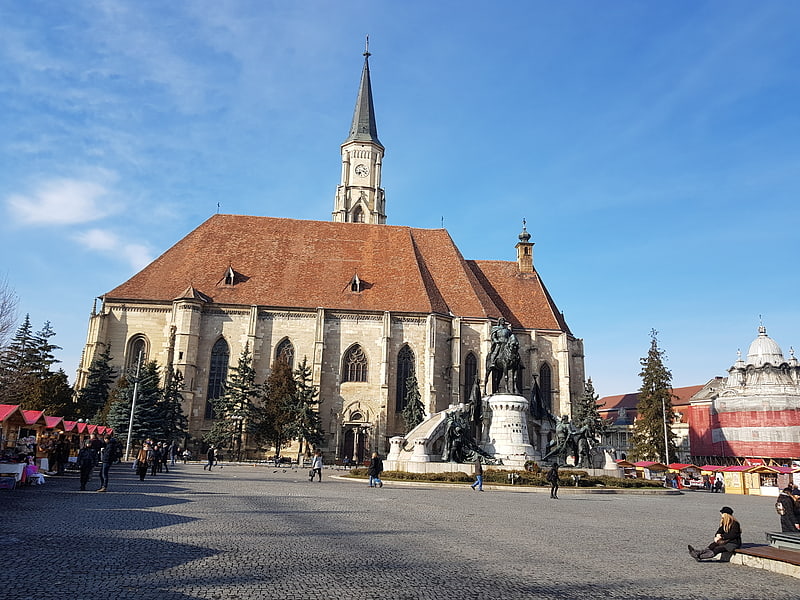
Also known as: Biserica Sfântul Mihail din Cluj-Napoca
Large gothic-style Catholic church. The St. Michael's Church is a Gothic-style Roman Catholic church in Cluj-Napoca. It is the second largest church in the geographical region of Transylvania, Romania. The nave is 50 meters long and 24 meters wide, the apse is 20×10 m. The tower with its height of 76 meter is the highest one in Transylvania.[1]
Address: Piața Unirii, 400015 Cluj-Napoca
Cluj-Napoca Botanical Garden
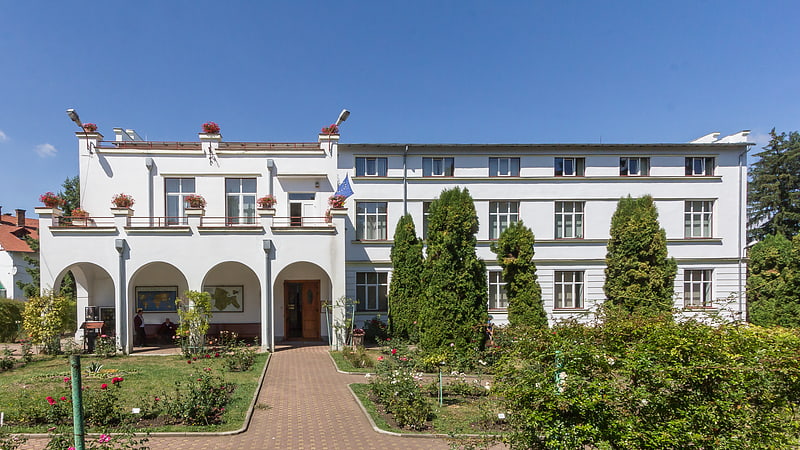
Also known as: Grădina Botanică din Cluj-Napoca
Botanical garden with exotic flowers. The Cluj-Napoca Botanical Garden, officially Alexandru Borza Cluj-Napoca University Botanic Garden, is a botanical garden located in the south part of Cluj-Napoca, Romania. It was founded in 1872 by Hungarian linguist Sámuel Brassai, known as the "Last Transylvanian Polymath". Its director in 1905 was Aladár Richter, then Páter Béla, Győrffy István, and then, in 1920, it was taken over by the local university and by Alexandru Borza.
In addition to its role as a tourist destination, the garden also serves as a teaching and research center as part of the Babeș-Bolyai University. In 2010, the Romanian Ministry of Culture and National Patrimony categorized it as a historical monument.
The garden is over 14 hectares in area, with over 10,000 plants found throughout the world. It is divided into ornamental, phytogeographic (geobotanical), systematic (taxonomical), economic, and medicinal sections. Romanian flora and vegetation are represented by plants from the Transylvanian plains, the Carpathian Mountains, Banat, etc.
Among the Botanical Garden's interesting attractions are the Japanese Garden (a garden in Japanese style, with a brook and a Japanese-style house), the Roman Garden with archeological remains from the Roman colony of Napoca, among them a statue of Ceres, goddess of cereals and bread, alongside cultivated plants that dominate contemporary Romanian agriculture. Jablonovszki Elemér was its head gardener for 45 years.[2]
Address: Strada Republicii 42, 400015 Cluj-Napoca
National Art Museum
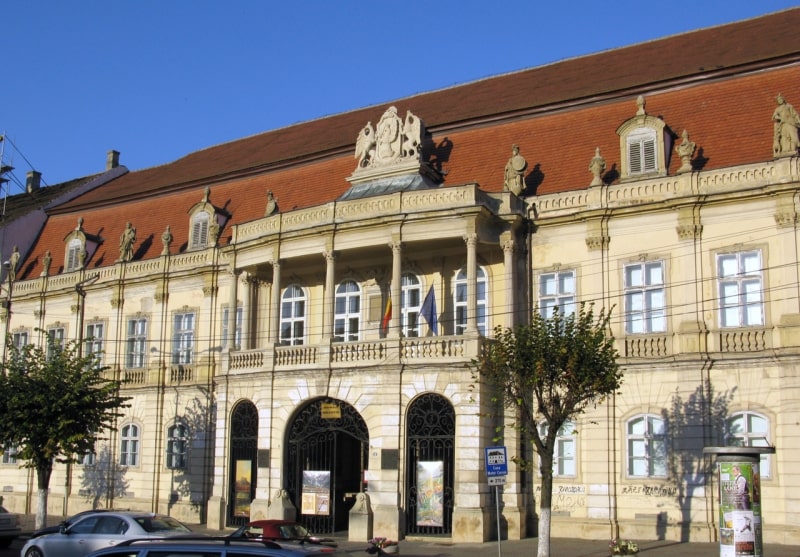
Also known as: Muzeul de Artă din Cluj-Napoca
Museum. The Museum of Cluj-Napoca or National Art Museum, Cluj-Napoca, is an art museum housed in an important eighteenth-century Baroque building, the Cluj-Napoca Bánffy Palace, designed by German architect Johann Eberhard Blaumann. The museum possesses a very valuable collection of Romanian and European art: paintings, graphics and decorative art ranging from the Fifteenth Century to the Twentieth.[3]
Address: Piata Unirii 30, 400098 Cluj-Napoca
Cluj Arena
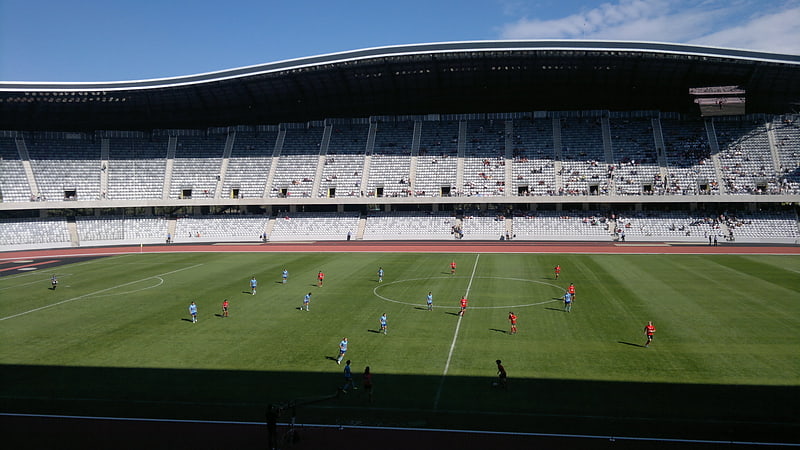
Multi-purpose stadium in Cluj-Napoca, Romania. Cluj Arena is a multi-purpose stadium in Cluj-Napoca, Romania. It serves as the home of Universitatea Cluj of the Liga II and was completed on 1 October 2011. It is also the home of the Untold Festival. The facility, owned by the county council of Cluj, can also be used for a variety of other activities such as track and field events and rugby union games. It replaced the Stadionul Ion Moina, which served as Universitatea Cluj's home from 1919 until the end of the 2007-08 season.
The stadium seats 30,201, making it the fifth largest stadium in Romania by seating capacity. It has four two-tiered stands, all of them covered. The seats of the stadium are grey.
The building is located west of Central Park, and next to the Someșul Mic river and the BT Arena.[4]
Calvaria Church

Also known as: Biserica Calvaria de la Cluj-Mănăștur
Catholic church with old fortifications. Calvaria Church was built in the small village of Mănăștur near Cluj-Napoca. A small Benedictine abbey surrounded by defensive walls, Calvaria Church was built starting in the 9th-10th centuries.[5]
Address: Aleea Grădini Mănăştur, Cluj-Napoca
Matthias Corvinus House
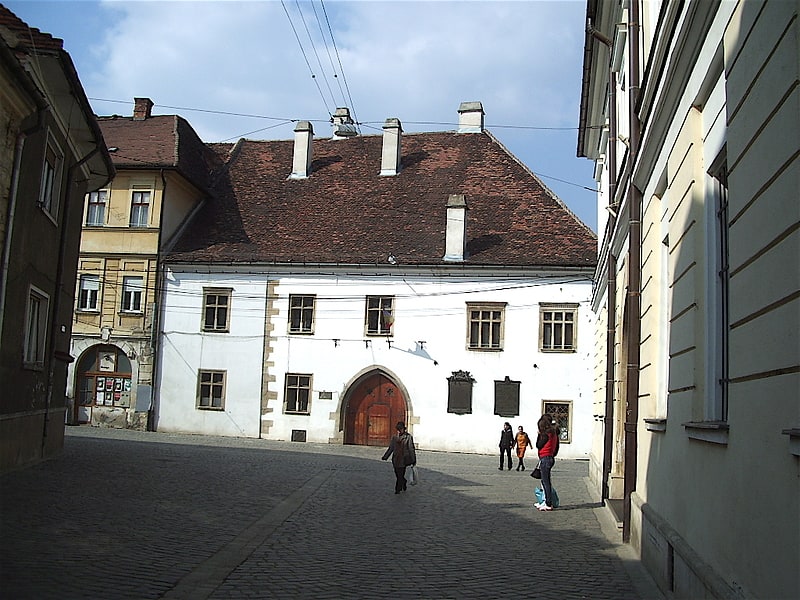
Also known as: Casa Matia din Cluj-Napoca
Museum in Cluj-Napoca, Romania. The Matthias Corvinus House is one of the oldest buildings in Cluj-Napoca, Transylvania, Romania. It was built in the 15th century, in the gothic style, as a small guesthouse. During its history, the house served as a jail, hospital, and museum; it is now home to a visual arts institute.
Matthias Corvinus (Hungarian: Hunyadi Mátyás, Romanian: Matia Corvin), son of John Hunyadi, later one of the most renowned Kings of Hungary, was born in this building on 23 February 1443. That time the house was owned by Jakab (James) Méhffi, who was a well-to-do wine-grower and merchant in the city. On 28 September 1467, king Matthias gave tax and duty exemption privilege for all descendants of the Méhffi family, the owner of the building.
The house has been owned by the Art and Design University of Cluj-Napoca since 1950.[6]
Address: Piata Unirii, Cluj-Napoca
Stadionul Dr. Constantin Rădulescu
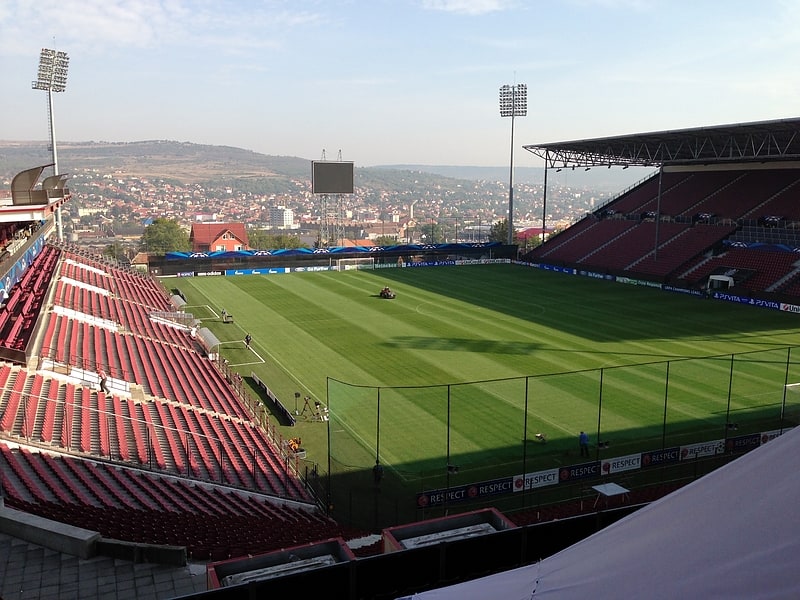
Stadium in Cluj-Napoca, Romania. Dr. Constantin Rădulescu Stadium, informally also known as CFR Cluj Stadium, is a football-only stadium in the Gruia district, Cluj-Napoca, Romania and is home ground of CFR Cluj. The stadium is named after Constantin Rădulescu, a former player, coach and club doctor.[7]
Dormition of the Theotokos Cathedral
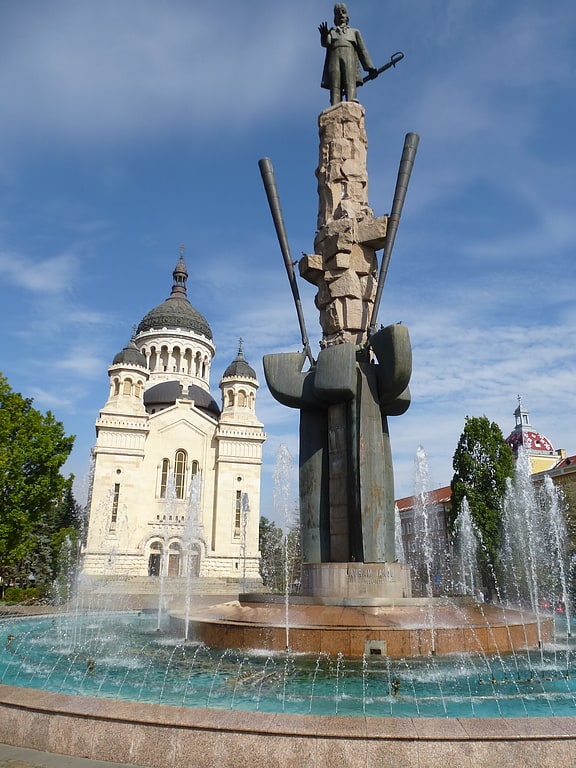
Also known as: Catedrala Mitropolitană din Cluj-Napoca
15th-century building and art institution. The Dormition of the Theotokos Cathedral is the most famous Romanian Orthodox church of Cluj-Napoca, Romania. Built in a Romanian Brâncovenesc style, a synthesis of Renaissance and Byzantine architecture, it lies on the Avram Iancu Square, together with the Cluj-Napoca National Theatre and the Avram Iancu Statue.
The Cathedral is the seat of the Metropolitan of Cluj, Alba, Crișana and Maramureș. It is dedicated to the Dormition of the Theotokos (Romanian: Adormirea Maicii Domnului).[8]
Address: Piata Avram Iancu, 400117 Cluj-Napoca
Bánffy Palace

Also known as: Palatul Bánffy din Cluj-Napoca
Palace in Cluj-Napoca, Romania. Bánffy Castle is a baroque building of the 18th century in Cluj-Napoca, designed by the German architect Johann Eberhard Blaumann. Built between 1774 and 1775 it is considered the most representative for the baroque style of Transylvania. The first owner of the palace was the Hungarian duke György Bánffy, the governor of Transylvania.
Francis II, Holy Roman Emperor and his wife Caroline Augusta of Bavaria were hosted in the palace during their visit in Kolozsvár, between 18 and 27 August 1817. This was the first occasion when a ruler from the Habsburg family visited the city. Franz Joseph I of Austria was also the guest of the palace between 2-4. August 1852 and 22–24 September 1887. The palace (along with the Răscruci castle of the Bánffy family) features in the reminiscences of an English governess, Florence Tarring, who worked for one of the branches of the Bánffy family during the First World War (1914-1919).
In February 1951 the council of the city decided to empty the palace to establish an Art Museum there; the works were finished in the summer of 1954. The museum was opened in the restored palace on 30. December 1965. The cinema occupying the inner yard of the palace was demolished in 1974.
The floor area of the palace is 66×48 m, its inner yard is 26×26 m. The wings on the sides include one row of rooms while the front and back wing includes two rows. The yard is surrounded by a portico at the second-floor level.
The facade is decorated with statues of Mars, Minerva, Apollo, Diana, Hercules, Perseus, and the coat of arms of the Bánffy family with gryphons, without crown. In the median risalit there is a gate, above this is a loggia with seven pillars.[9]
Address: Piata Unirii 30, 400098 Cluj-Napoca
Avram Iancu Square
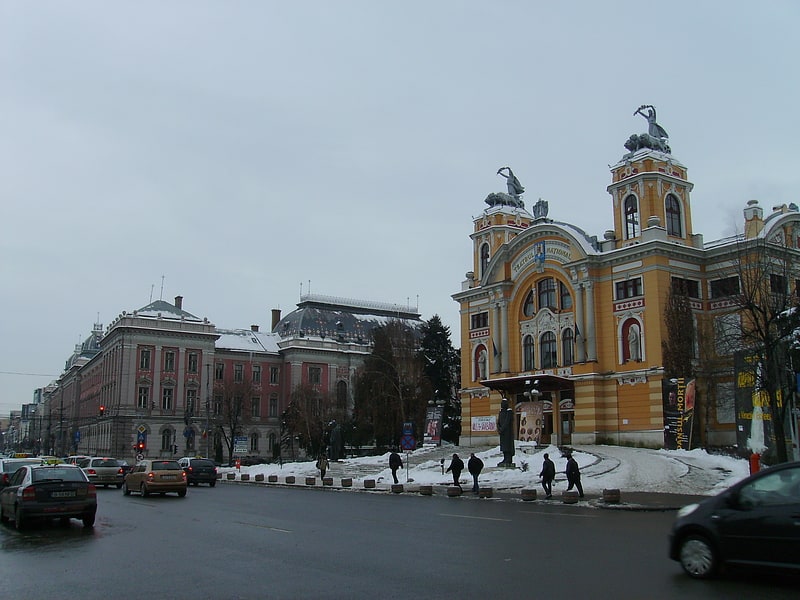
Also known as: Piața Avram Iancu din Cluj-Napoca
Avram Iancu Square is a central plaza in the Romanian city of Cluj-Napoca. It is connected to the Unirii Square through the Eroilor and "21 Decembrie 1989" avenues. It is also connected to Mihai Viteazul Square through Cuza Vodă Street. Its most prominent building is the Dormition of the Theotokos Cathedral, although the plaza also houses the Wagner Gyula's eclectic Palace of Justice, the Lucian Blaga National Theatre and the headquarters of the County Prefecture.[10]
Academic College
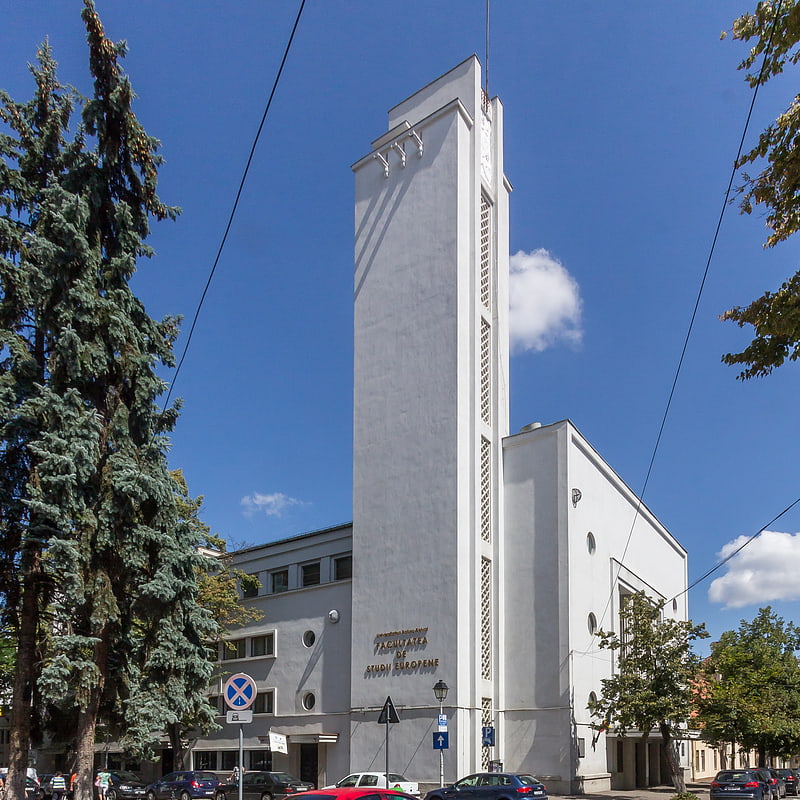
The Academic College is an Art Deco building in Cluj-Napoca, Romania, belonging to Babeș-Bolyai University and located on M. Kogălniceanu Street.[11]
Address: 1 Strada Emmanuel de Martonne, Cluj-Napoca
Cluj-Napoca Central Park
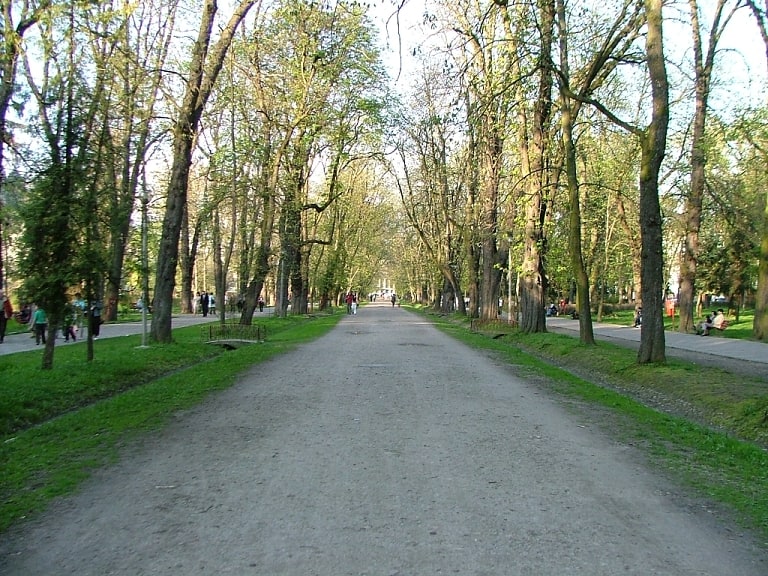
Also known as: Parcul Central din Cluj-Napoca
Sizable, scenic recreational park. Central Park is a large public, urban park in central Cluj-Napoca. It was founded in the 19th century and it located on the southern shore of Someşul Mic River. The Park is now home to the University of Arts and Design and to the Chemistry Faculty of the Babeş-Bolyai University.
During 2012, the Central Park was site of an important restoration process, especially for the building of the Old Casino.
Every year, the west half of the park is closed off as part of the Untold Festival.[12]
Address: Strada cardinal Hossu Iuliu, 400029 Cluj-Napoca
BTarena
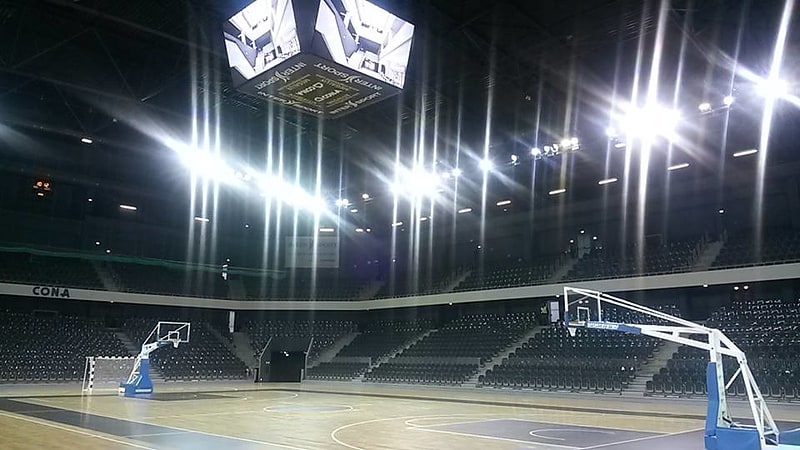
Also known as: BT Arena
Arena in Cluj-Napoca, Romania. The BTarena is a multi-purpose indoor arena that is located in Cluj-Napoca, Romania. The arena was previously called the Polyvalent Hall but was renamed on 17 October 2017 when the facility entered into a new arena-naming rights agreement with Banca Transilvania. The venue holds 10,000 people in its largest configuration. The building is located next to the Cluj Arena.[13]
Address: Strada Uzinei Electrice, 400378 Cluj-Napoca
Tailors' Bastion

Also known as: Bastionul Croitorilor din Cluj-Napoca
Fortress ruins with a repurposed tower. The Cluj-Napoca Tailors' Tower is located at the southeast corner of the old Cluj-Napoca citadel. It was built in the 15th century and rebuilt between 1627 and 1629, assuming its present form. It was named after the Tailors' Guild, who took care of and guarded this part of the city. Near the tower — where Baba Novac, general of Michael the Brave and Saski priest, was killed in 1601 by General Basta — there is a statue of Baba Novac.
Deserted until 2007, the municipality of Cluj-Napoca undertook to include the tower in the city's touristic itinerary, financing its restoration.
The tower is now a Centre for Urban Culture, based on a project offered by the Transilvanian Branch of the Architects’ Chamber of Romania in collaboration with BAU (Birou de Arhitectura si Urbanism). The Centre hosts an flexible exhibition space on its three floors being also used for different events such as conferences.[14]
National Museum of Transylvanian History
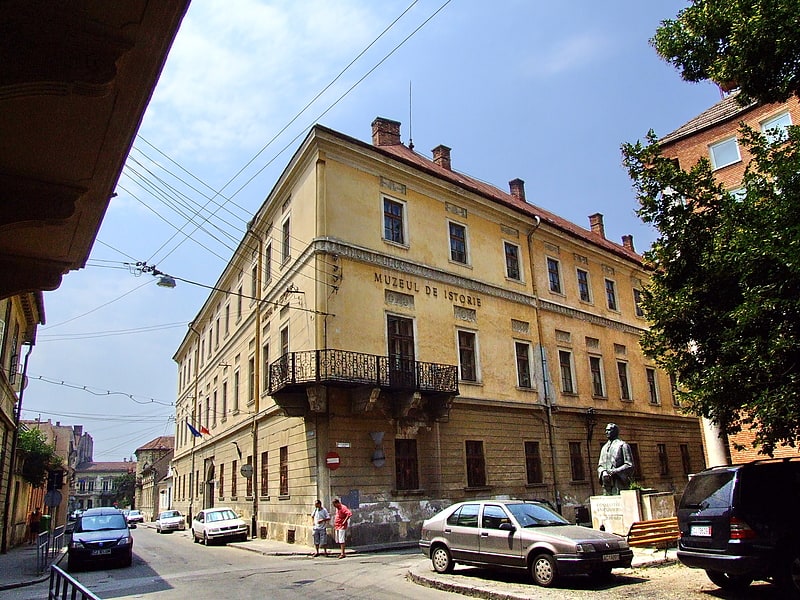
Also known as: Muzeul Național de Istorie a Transilvaniei
Museum in Cluj-Napoca, Romania. The National Museum of Transylvanian History is a history and archaeology museum in the city of Cluj-Napoca, Romania. It features a permanent exhibition, as well as temporary exhibitions, the "Tezaur" exhibition, and Pharmacy Historical collection—this last opened in the Hintz House, an historical building in the city's center.
The beginnings of the museum date back to 1859 with the foundation of the Society of the Transylvanian Museum, featuring collections of antiquities and botanical, zoological and mineralogical specimens. In 1929 the collection of artefacts was transferred to the Romanian Institute of Classical Studies. After several further movements, caused by lack of space, the collection was reopened in 1937 at its current site in Piaţa Muzeului, in the center of Cluj-Napoca.[15]
Address: Str. Constantin Daicoviciu, nr. 2, Cluj-Napoca
Cluj-Napoca Hungarian Opera
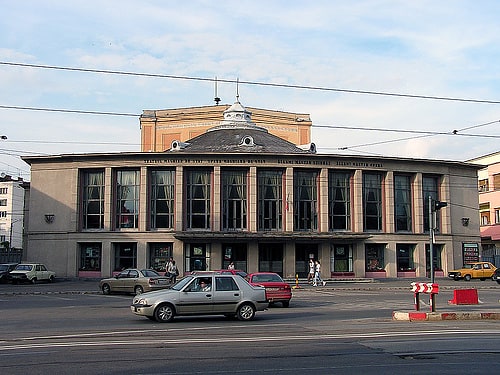
Also known as: Opera Maghiară din Cluj
Opera company. The Cluj-Napoca Hungarian Opera is an opera company in Cluj-Napoca, Romania, founded on 17 December 1948. It resides at the Hungarian Theatre of Cluj.
The structure was built during 1909–1910 on the site of an old summer theatre, and was reconstructed in 1959–1961. The ensemble can host up to 862 people.[16]
Hungarian Theatre of Cluj

Also known as: Teatrul Maghiar de Stat din Cluj-Napoca
Theatre in Cluj-Napoca, Romania. The State Hungarian Theatre of Cluj is a theatre in Cluj-Napoca, Romania. Performances are played in Hungarian, with simultaneous translation into Romanian or English usually available.
The structure, built during 1909-1910 and reconstructed in 1959-1961, can seat 862 people in the main auditorium. The building, which also houses the Cluj-Napoca Hungarian Opera, is listed in the National Register of Historic Monuments.[17]
Address: Strada Isac Emil, 400023 Cluj-Napoca
Bob Church
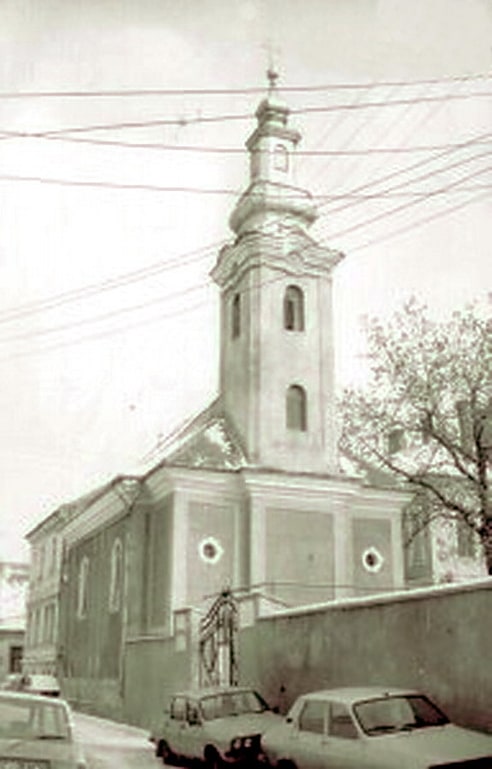
Also known as: Biserica Bob din Cluj-Napoca
Church in Cluj-Napoca. The Bob church is the first Greek-Catholic church that was built in 1803 in the city of Cluj, Transylvania, at that time part of the Austrian Empire. The name of the church comes from the Romanian noble Ioan Bob, later bishop of the Romanian Greek-Catholic church, who paid for the construction of the church.
On 7 August 1864, Veronica Micle married here Ștefan Micle, the future Rector of the University of Iași.[18]
Cluj-Napoca Unitarian Church

Also known as: Biserica Unitariană din Cluj-Napoca
Church in Cluj-Napoca, Romania. The Cluj-Napoca Unitarian Church is a Unitarian church located in Cluj-Napoca, Romania.
Built in a late Baroque style between 1792 and 1796, according to the plans of Anton (Antal) Türk, the apse is semicircular and the vestibule faces south. A two-story spire with an onion-shaped roof dominates the facade. The upper parts of the facade are somber compared to the lower, which features tall niches between the pilasters. The central niche contains the portal, topped by an ellipse-shaped window, a small and amply sculpted balcony and another window in the shape of an arch segment. The pilasters have Doric and Ionic capitals, while the Neoclassical stucco decor includes sculpted shells, garlands and grape bunches. The church is listed as a historic monument by Romania's Ministry of Culture and Religious Affairs.[19]
Address: Bulevardul 21 Decembrie 1989, Cluj-Napoca
Piarist Church
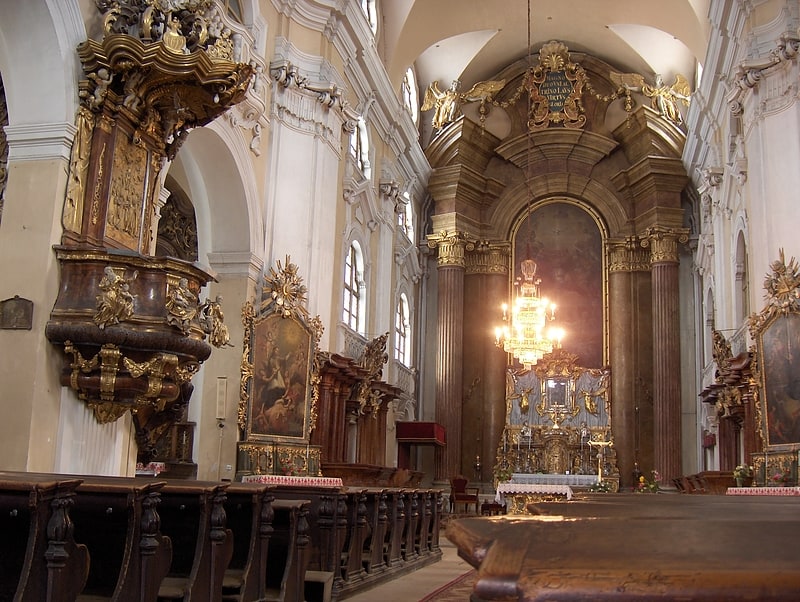
Also known as: Biserica Piariștilor din Cluj-Napoca
Baroque-style 18th-century church. The Piarist Church, located at 5 Str. Universității, Cluj-Napoca, Romania, and dedicated to the Holy Trinity, was the first Roman Catholic church built in Transylvania after the Protestant Reformation, as well as the province's first Baroque church building. Among the city's more notable edifices, it served as a prototype for numerous other churches in Transylvania. It features a strong contrast between the sober exterior and a very well-decorated, almost exuberant interior. A statue of the Virgin Mary stood in front of the church until 1959, when the Communist authorities moved it to another part of the city.[20]
Address: 5 Strada Universității, Cluj-Napoca